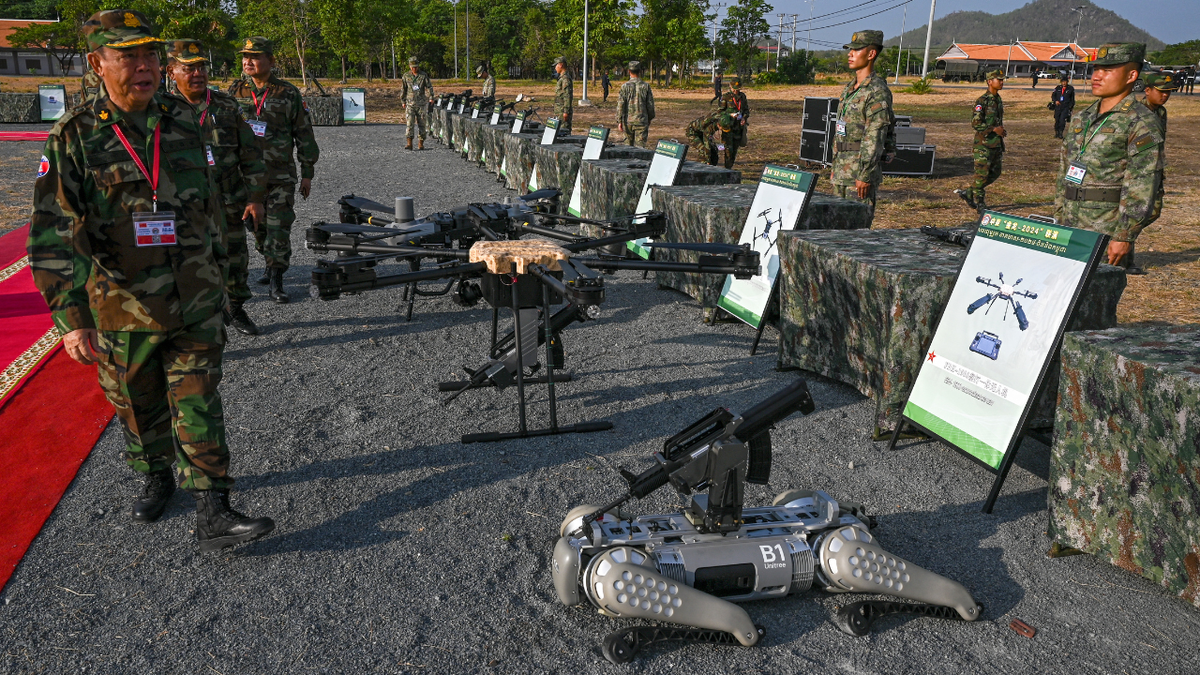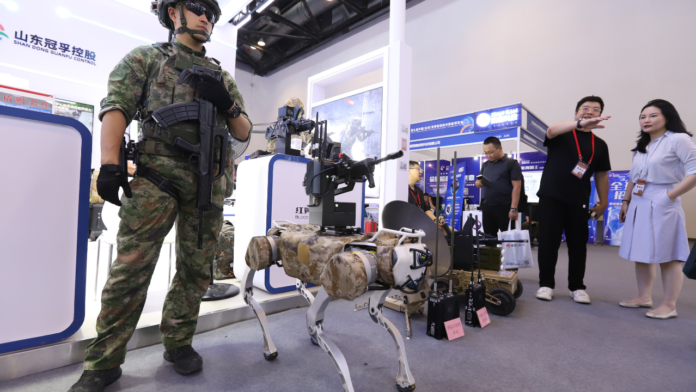A Republican lawmaker is sounding the alarm on the latest threat from China – rifle-toting AI robot dogs.
A Chinese state media video, screenshots of which were published by the Military Times, showed that country’s military displaying dog-like robots toting rifles during joint drills in Cambodia.
The AI dogs weigh 110 pounds and can carry and fire automatic rifles autonomously, according to the outlet.
While drone warfare is not a novel concept, some believe the rise of these new armed automatons should cause concern stateside.
IN THE ONLY STATE BORDERING RUSSIA, ALASKA GOVERNOR SAYS ITS DEFENSES ARE STRONG

Visitors view a fighting robot dog during the 9th China (Beijing) Military Intelligent Technology Expo at the China National Convention Center in Beijing. (Guo Haipeng/VCG via Getty Images)
Rep. Vern Buchanan, R-Fla., told Fox News Digital that advanced AI is the next major economic and military frontier for both the U.S. and its adversaries like China.
Of 18 amendments he authored and successfully saw passed via the House draft of the National Defense Authorization Act (NDAA), one drew attention to the potentially game-changing threat.
Buchanan’s legislation added a provision that would direct the secretary of defense to report on the threat of China’s use of AI in the military, including such robot-dogs, and their national security threat to the U.S.
“If we don’t pay attention to what other countries around the world are doing on the AI front, we risk losing our standing on the global stage and position as the world’s preeminent fighting force,” Buchanan said.
“Anyone that tells you that China will only be using these for purely peaceful purposes has their head in the sand.”
The Pentagon did not immediately respond to a request for comment. But, according to a May report from The Warzone, the Marine Corps’ Special Forces Operation Command – or MARSOC – has two similar robotic quadrupeds that it is currently using for perimeter security in unspecified locations.
LANDMARK BILL TARGETS HIDDEN FOREIGN FUNDS IN SCHOOLS AS OFFICIALS WARN OF CCP INFLUENCE

Deputy Commander-in-Chief of the Royal Cambodian Armed Forces and commander of the Royal Cambodian Army, General Mao Sophan, inspects drones and a machine gun equipped robot battle dog displayed in front of Chinese soldiers at a military police base in Kampong Chhnang province. (TANG CHHIN SOTHYTANG CHHIN SOTHY/AFP via Getty)
Buchanan said the U.S. has experimented with such similar robotic dogs in the past, but China affixing weapons to them and showing them off via military exercises is worrisome.
“[This] should make everyone take notice and ensure our military is staying one step ahead of them at every turn,” he said.
When asked whether the Democratic-led Senate is likely to strip the provision from its draft for the final compromise legislation, Buchanan said he had no reason to believe so.
He suggested the “common-sense” reporting requirement should be noncontroversial as a matter of national security.
“We’ve received a lot of positive feedback about our amendment. The fact that it passed without opposition from a single member of Congress on either side of the aisle should tell you everything you need to know,” he added.

Then-Rep. Mike Pence, R-Ind., listens as Rep. Vern Buchanan, R-Fla., speaks. (Getty)
While he alone drafted the amendment to the NDAA, Buchanan said that many other lawmakers are extremely concerned about AI-related threats from China and other adversaries.
Asked about the robot dogs and the reporting amendment, Rep. Mike Rogers, R-Ala., the chairman of the House Armed Services Committee who chief-sponsored the NDAA, suggested that such concerns are valid.
“Prioritizing innovation is vital if we want to stay ahead of China,” Rogers said.
“The FY25 NDAA continues to make investments in innovative emerging technologies, like AI, to ensure that our military remains the most capable and lethal force in the world.”
The Senate is due to take up debate on the NDAA in the near term, after House passage of its version fell largely along party lines at 217-199.
Source link





